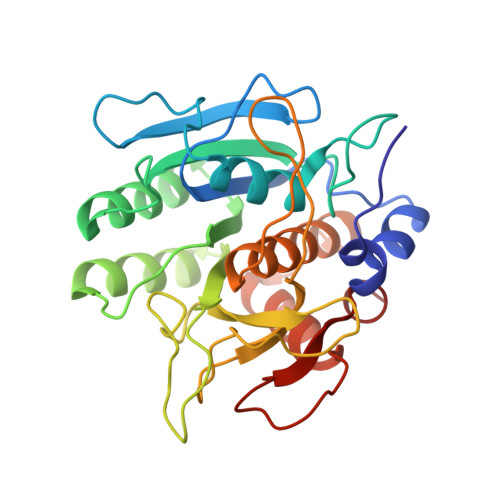Inactivation of subtilisin Carlsberg by N-((tert-butoxycarbonyl)alanylprolylphenylalanyl)-O-benzolhydroxyl- amine: formation of a covalent enzyme-inhibitor linkage in the form of a carbamate derivative.
Steinmetz, A.C., Demuth, H.U., Ringe, D.(1994) Biochemistry 33: 10535-10544
- PubMed: 8068694
- DOI: https://doi.org/10.1021/bi00200a040
- Primary Citation of Related Structures:
1SCN - PubMed Abstract:
The mechanism of inactivation of serine proteases by N-peptidyl-O-aroylhydroxylamines was studied by X-ray crystallography. Cocrystals of subtilisin Carlsberg inactivated with N-((tert-butoxycarbonyl)alanylprolylphenylalanyl)-O-nitrobenzoy lhydroxylamine were grown, and diffraction data to 1.8-A resolution were obtained. The resulting electron density maps clearly reveal that the gamma-oxygen of the catalytic serine forms a carbamate derivative with the inhibitor. The peptide part of the inhibitor does not form the usual antiparallel beta-sheet in the P binding cleft but protrudes out of the active site and is stabilized by a network of water molecules. These results, combined with kinetic characterization reported previously [Demuth, H.-U., Schoenlein, C., & Barth, A. (1989b) Biochim. Biophys. Acta 996, 19-22; Schmidt, C., Schmidt, R., & Demuth, H.-U. (1990) Peptides (Giralt, E., & Andreu, D., Eds.) ESCOM Science Publishers B.V., Amsterdam] support the existence of at least one intermediate between the formation of the Michaelis complex and the final product. We suggest a mechanism for the inactivation of subtilisin Carlsberg by N-((tert-butoxycarbonyl)alanylprolylphenylalanyl)-O-benzoylhydr oxylamine whereby a negatively charged Michaelis complex undergoes a Lossen rearrangement giving rise to an isocyanate intermediate that reacts with the side chain of the active site serine.
- Department of Biochemistry, Brandeis University, Waltham, Massachusetts 02254.
Organizational Affiliation:



















